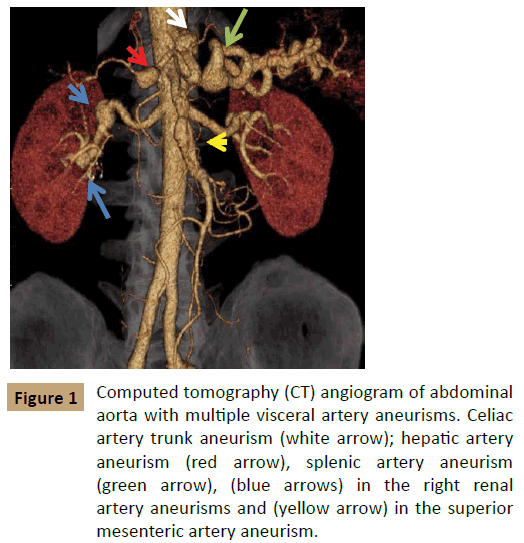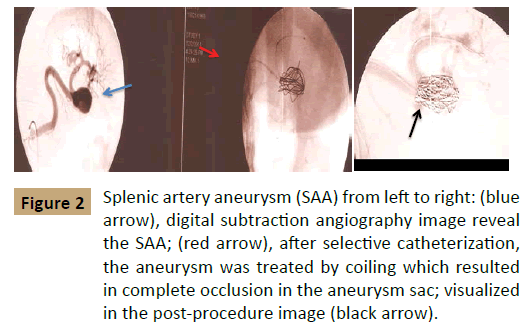Embolization for Visceral Artery Aneurisms: What s Your Opinion?
Paulo Eduardo Ocke Reis
DOI10.21767/2573-4482.10001
Paulo Eduardo Ocke Reis1,3*, Leonardo Roever2 and Irlandia Figueira Ocke Reis3
1Department of Specialized and General Surgery, Fluminense Federal University,Rio de Janeiro, Brazil
2Department of Clinical Research, Federal University of Uberlandia, Brazil
3Vascular Clinic Ocke Reis, Rio de Janeiro,Brazil
- *Corresponding Author:
- Paulo Eduardo Ocke Reis
Department of Specialized and General Surgery Fluminense Federal University
Rio de Janeiro, Brazil
Tel: +55 21 2629-5000
E-mail: vascular@pauloocke.com.br
Received date: February 20, 2016; Accepted date: February 24, 2016; Published date: February 28, 2016
Citation: Reis PEO, Roever L, Reis IFO. Embolization for Visceral Artery Aneurisms: What’s Your Opinion? Journal of Vascular& Endo Surgery. 2016, 1:1. doi: 10.21767/2573-4482.100001
Keywords
Visceral artery aneurysm; Asneurysm rupture; Embolization; Coil embolization
De Bakey and Cooley did the first successful operation for a visceral artery aneurysm (VAA) in 1953 [1]. They are relatively rare and the risk of rupture is associated with high mortality [2-6]. The majority of patients are asymptomatic prior to rupture and the main indication of elective treatment is size; VAA larger than 2 cm and aneurysms in women of childbearing age is recommended [1-7]. The goal of treatment is to prevent aneurysm expansion by excluding it from the arterial circulation saving branchs patency and freedom from rupture or reperfusion [8-10]. Surgery has been considered the treatment of VAA for several decades, but now a days endovascular procedures as embolization or covered stents have increased the treatment options available to comorbid patients not suitable for open repair [7-10].
VAAs are seen more often these days with the more widespread use of computed tomography [7-10] (Figure 1). Angiography remains the “gold standard” in the preoperative imaging and allows concomitant endovascular interventions, determining proper landing zones in the proximal and distal non aneurysmal segments of the artery for stent-grafts, as well as for determining whether the neck morphology is adequate for coil embolization [11] (Figure 2). Embolization of the entire splenic artery at its origin was considered at first, but after thorough deliberation, it was not considered optimal treatment because of the risk of splenic infarction or splenic artery aneurysm recurrence [12].
Figure 1: Computed tomography (CT) angiogram of abdominal aorta with multiple visceral artery aneurisms. Celiac artery trunk aneurism (white arrow); hepatic artery aneurism (red arrow), splenic artery aneurism (green arrow), (blue arrows) in the right renal artery aneurisms and (yellow arrow) in the superior mesenteric artery aneurism.
Figure 2: Splenic artery aneurysm (SAA) from left to right: (blue arrow), digital subtraction angiography image reveal the SAA; (red arrow), after selective catheterization, the aneurysm was treated by coiling which resulted in complete occlusion in the aneurysm sac; visualized in the post-procedure image (black arrow).
Coil embolization techniques are often used to “trap’” the aneurysm between coils placed proximally and distally within the normal part of the parent artery [11,13,14]. This technique is well suited for aneurysms in larger arteries but requires adequate collateral circulation to the end organ. VAA can often be excluded from the circulation in this way by coil embolization of first the distal and then the proximal segment of the parent artery. For smaller arteries, coils or particles placed in distal branches can be used successfully [11,13,14]. Contrast-enhanced magnetic resonance angiography (CE-MRA) at 3T provides high-quality images equivalent to digital subtraction angiography (DSA) for the evaluation of VAAs after coil embolization. We suggest that CE-MRA at 3T might be used as the primary method for follow-up of VAAs after coil embolization [15]. Endovascular approach, treatment can be done with different techniques and devices [7-10, 16,17]. It depends on the anatomy localization and morphology of the VAA. Arterial patency can be preserved in secular aneurysms, in which neck catheterization allows embolization limited to the sac [11,13,14,16,17] (Figure 2). Embolization is successfully used as a treatment option and is another endovascular option for VAA treatment. For successful management without major complications, a sufficient collateral supply is mandatory [7, 9-11, 13,14,16,17]. Modern endovascular techniques with promising short- and long-term results could broaden indications to treat asymptomatic VAA [18]. The promising results of endovascular treatment in elective settings could lead to broader indications, thus reducing life-threatening rupture [18]. However, increased percutaneous endovascular interventions have raised the incidence of iatrogenic visceral artery pseudoaneurysms (VAPAs) [19]. There seems to be no correlation between aneurysm size and associated rupture rate in VAPA. Thus, all VAPAs should undergo prompt repair via either open or endovascular surgery [18]. These catheter-based techniques constitute an excellent approach in the elective setting [19]. Studies could also compare the mid- and long- term results of coiling [19].
The advances with embolization techniques in the last decades are quite evident, and the field of endovascular surgery and minimally invasive techniques has accompanied this development, aiming at overcoming its limitations. However still needs improvement when it comes to long-term evaluation. The technological advances and the development of new devices that may significantly help and provide effective and safe results in the treatment of those patients with VAA.
References
- DeBakey ME, Cooley DA (1953) Successful resection of mycotic aneurysm of superior mesenteric artery; case report and review of literature. Am Surg 19: 202-212.
- Moore SW, Guida PM, Schumacher HW (1970) Splenic artery aneurysm. Bull SocIntChir 29: 210–218.
- Shanley CJ, Weinberger JB (2008) Acute abdominal vascular emergencies. Med Clin North Am 3: 627–647.
- Funahashi S, Yukizane T, Yano K (1997) An aneurysm of the right gastroepiploic artery. J Cardiovasc Surg (Torino) 38: 385-388.
- De Angelis M, Vogel C, Horowitz B (1994) Ruptured gastroepiploic aneurysm. J ClinGastroenterol 18: 261-262.
- Walter M, Opitz I, Lohr G (2001) Symptomatic aneurysm of the right gastroepiploic artery. Case report and review of the literature Chirurg 72: 437-440.
- Gehlen JMLG, Heeren PAM, Verhagen PF, Peppelenbosch AG (2011) Visceral Artery Aneurysms. Vascular and Endovascular Surgery 45: 681-687.
- Ikeda O, Tamura Y, Nahkasone T (2008) Nonoperative management of unruptured visceral aneurysms: treatment by transcatheter coil embolization. J Vasc Surg 47: 1212– 1219 .
- Saltzberg SS, Maldonado TS, Lamparello PJ (2005) Is endovascular therapy the preferred treatment for all visceral artery aneurysms. Ann Vasc Surg 19: 507–515.
- Tulsyan N, Kashyap VS, Greenberg RK (2007) The endovascular management of visceral artery aneurysms and pseudoaneurysms. J Vasc Surg 45: 276–283.
- Caron B Rockman, Thomas S Maldonado (2010) Splanchinic Artery Aneurisms. Rutherford`s Vascular Surgery.
- Carr SC, Pearce WH, Vogelzang RL (1996) Current management of visceral artery aneurysms. Surgery 120: 627-634.
- McDermott VG, Shlansky-Goldberg R, Cope C (1994) Endovascular management of splenic artery aneurysms and pseudoaneurysms. CardiovascInterventRadiol 17: 179-184.
- Baggio E, Migliara B, Lipari G, Landoni L (2004) Treatment of six hepatic artery aneurysms. Ann Vasc Surg 18: 93-99.
- Yasuhiko I, Ichiro I, Toshinori H, Kazuchika Y, Yasuyuki Y (2013) Evaluation of contrast-enhanced MR angiography in the follow-up of visceral arterial aneurysms after coil embolization. ActaRadiologica 54: 493-497.
- Lagana D, Carrafiello G, Mangini M (2006) Multimodal approach to endovascular treatment of visceral artery aneurysms and pseudoaneurysms. Eur J Radiol 59: 104–111.
- Park SJ, Kwon SW, Oh JH, Park HC (2009) Glue Embolization of a Ruptured Celiac Trunk Aneurysm. Vascular 17: 112-115.
- Regus S, Lang Werner (2016) Rupture Risk and Etiology of Visceral Artery Aneurysms and Pseudoaneurysms: A Single-Center Experience. Vascular and Endovascular Surgery 50: 10-15.
- Loffroy R, Favelier S, Pottecher P (2015) Endovascular management of visceral artery aneurysms: When to watch, when to intervene. World J Radiol 7: 143-148.
Open Access Journals
- Aquaculture & Veterinary Science
- Chemistry & Chemical Sciences
- Clinical Sciences
- Engineering
- General Science
- Genetics & Molecular Biology
- Health Care & Nursing
- Immunology & Microbiology
- Materials Science
- Mathematics & Physics
- Medical Sciences
- Neurology & Psychiatry
- Oncology & Cancer Science
- Pharmaceutical Sciences


